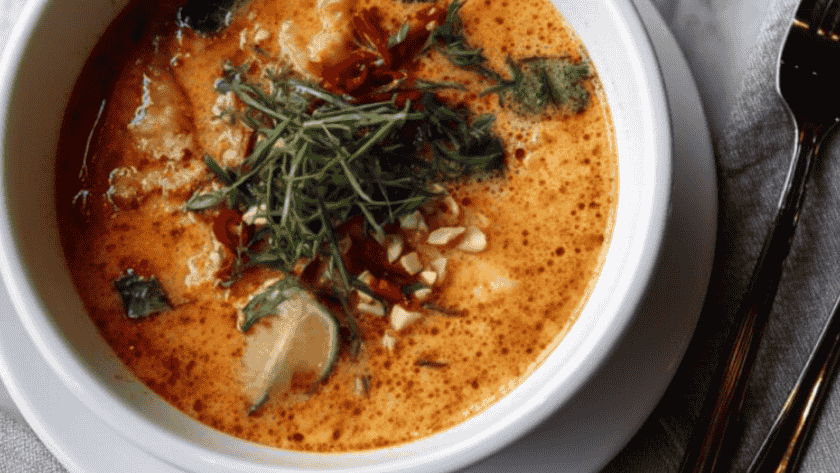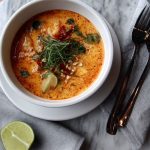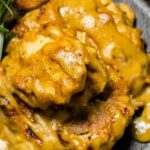Mary Berry’s Panang Chicken is a rich and creamy Thai-inspired curry with a mild, nutty, and slightly sweet flavour. It’s made with tender chicken simmered in coconut milk, aromatic Panang curry paste, and crushed peanuts — creating a perfect balance of spice and creaminess. This dish is comforting, quick to prepare, and ideal for a weeknight dinner or special occasion when you want something full of flavour yet simple to make.
What is Mary Berry Panang Chicken?
Panang Chicken is a Thai curry made with Panang curry paste, coconut milk, and chicken. It’s thicker and creamier than traditional Thai curries, with flavours of lemongrass, lime leaves, and ground peanuts. Mary Berry’s version simplifies the traditional recipe without losing authenticity — offering a delicious, easy-to-follow version perfect for home cooks.

Other Mary Berry Popular Recipes
- Mary Berry Vegetarian Quiche
- Mary Berry Hot Cross Buns
- Mary Berry Lemon Chicken
- Mary Berry Thai Chicken Curry
- Mary Berry Panang Chicken
Why This Recipe is Worth Trying
- Creamy and full-bodied – Coconut milk and peanuts give richness and depth.
- Quick and easy – Ready in under 30 minutes.
- Balanced flavour – Sweet, salty, spicy, and nutty all at once.
- Perfect for meal prep – Tastes even better the next day.
- Family-friendly – Mild spice that appeals to all palates.
Essential Ingredients to Make Mary Berry Panang Chicken
- 2 tbsp vegetable oil
- 1 onion, finely sliced
- 2 garlic cloves, crushed
- 1 tbsp fresh ginger, grated
- 2–3 tbsp Panang curry paste (adjust to taste)
- 600g boneless, skinless chicken breasts or thighs, cut into bite-sized pieces
- 400ml coconut milk (full-fat)
- 1 tbsp fish sauce
- 1 tbsp light soy sauce
- 1 tbsp brown sugar or palm sugar
- Zest and juice of 1 lime
- 2 kaffir lime leaves (optional, for aroma)
- 50g roasted unsalted peanuts, crushed
- Fresh coriander or Thai basil, for garnish
Handy Kitchen Tools for Best Results
- Large wok or deep frying pan
- Wooden spoon
- Chopping board and sharp knife
- Measuring spoons and a jug
- Serving bowls
Step-by-Step Guide to Making Mary Berry Panang Chicken
Step 1: Prepare the base
Heat the vegetable oil in a large wok over medium heat. Add the sliced onion and sauté for 3–4 minutes until soft and translucent.
Step 2: Add aromatics
Stir in the garlic and ginger, cooking for about 1 minute until fragrant.
Step 3: Add the curry paste
Add the Panang curry paste to the wok and cook for another 1–2 minutes, stirring constantly to release the flavours.
Step 4: Cook the chicken
Add the chicken pieces and stir until coated in the paste. Cook for 5 minutes until the chicken starts to brown lightly on all sides.
Step 5: Create the sauce
Pour in the coconut milk, fish sauce, soy sauce, and brown sugar. Stir to combine, then add the kaffir lime leaves if using. Bring to a gentle simmer.
Step 6: Simmer and finish
Reduce the heat to low and simmer for 10–12 minutes until the chicken is tender and the sauce thickens slightly. Add lime zest and juice, and stir in crushed peanuts for a creamy texture.
Step 7: Serve and garnish
Remove from heat and garnish with fresh coriander or Thai basil. Serve hot with steamed jasmine rice or noodles.

What I Got Wrong (And How I Fixed It)
- Sauce too runny – Simmered longer to reduce and thicken naturally.
- Too spicy – Used less curry paste and added a bit more coconut milk.
- Chicken dry – Lowered the heat during simmering for tender results.
Healthier Ways to Make Mary Berry Panang Chicken
- Use light coconut milk to reduce fat.
- Replace chicken with tofu or prawns for a leaner option.
- Add more vegetables such as bell peppers or green beans, for nutrients.
- Reduce sugar and balance flavour with extra lime juice instead.
Ingredient Substitutions for Mary Berry Panang Chicken
- Chicken → Prawns, tofu, or beef for variation.
- Peanuts → Cashews or almond butter for a different nutty profile.
- Fish sauce → Soy sauce for a vegetarian version.
- Coconut milk → Greek yogurt (added at the end) for a lighter sauce.
Pairing Ideas: What to Serve With Panang Chicken
- Steamed jasmine rice – Soaks up the creamy sauce.
- Coconut rice – Enhances the tropical flavour.
- Thai cucumber salad – Adds freshness and crunch.
- Flatbread or roti – Perfect for scooping up sauce.
- Stir-fried vegetables – Keeps the meal balanced.
Expert Tips for Panang Chicken Success
- Simmer gently – Avoid boiling to keep the sauce creamy.
- Use good-quality curry paste – It makes all the difference.
- Don’t skip lime juice – It brightens the rich flavours.
- Add crushed peanuts last – Keeps them slightly crunchy.
- Adjust consistency – Add more coconut milk if the sauce thickens too much.
Creative Ways to Customize Panang Chicken
- Add sliced red peppers or baby corn for texture.
- Mix in a spoon of peanut butter for extra creaminess.
- Top with chopped chillies for added heat.
- Add pineapple chunks for a sweet twist.
- Stir in fresh spinach or kale for a nutritious boost.
Storing Panang Chicken the Right Way
- Store in an airtight container in the fridge for up to 3 days.
- Freeze for up to 2 months; thaw before reheating.
- Avoid overcooking when reheating to keep the chicken tender.
How to Reheat Panang Chicken (If Needed)
- Stovetop: Warm gently over low heat, adding a splash of coconut milk or water.
- Microwave: Heat on medium power for 2–3 minutes, stirring halfway.
- From frozen: Thaw overnight, then reheat as above.
Nutritional Breakdown (per serving)
- Calories: ~420 kcal
- Protein: 30 g
- Carbohydrates: 12 g
- Fat: 28 g
- Fibre: 2 g
- Sugar: 5 g
Mary Berry Panang Chicken
Panang Chicken is a Thai curry made with Panang curry paste, coconut milk, and chicken. It’s thicker and creamier than traditional Thai curries, with flavours of lemongrass, lime leaves, and ground peanuts. Mary Berry’s version simplifies the traditional recipe without losing authenticity — offering a delicious, easy-to-follow version perfect for home cooks.
- Prep Time: 15
- Cook Time: 25
- Total Time: 40 minutes
- Yield: 4 1x
- Category: Main Course
- Method: Simmering
- Cuisine: Thai
Ingredients
-
2 tbsp vegetable oil
-
1 onion, finely sliced
-
2 garlic cloves, crushed
-
1 tbsp fresh ginger, grated
-
2–3 tbsp Panang curry paste (adjust to taste)
-
600g boneless, skinless chicken breasts or thighs, cut into bite-sized pieces
-
400ml coconut milk (full-fat)
-
1 tbsp fish sauce
-
1 tbsp light soy sauce
-
1 tbsp brown sugar or palm sugar
-
Zest and juice of 1 lime
-
2 kaffir lime leaves (optional, for aroma)
-
50g roasted unsalted peanuts, crushed
-
Fresh coriander or Thai basil, for garnish
Instructions
Heat the vegetable oil in a large wok over medium heat. Add the sliced onion and sauté for 3–4 minutes until soft and translucent.
Stir in the garlic and ginger, cooking for about 1 minute until fragrant.
Add the Panang curry paste to the wok and cook for another 1–2 minutes, stirring constantly to release the flavours.
Add the chicken pieces and stir until coated in the paste. Cook for 5 minutes until the chicken starts to brown lightly on all sides.
Pour in the coconut milk, fish sauce, soy sauce, and brown sugar. Stir to combine, then add the kaffir lime leaves if using. Bring to a gentle simmer.
Reduce the heat to low and simmer for 10–12 minutes until the chicken is tender and the sauce thickens slightly. Add lime zest and juice, and stir in crushed peanuts for a creamy texture.
Remove from heat and garnish with fresh coriander or Thai basil. Serve hot with steamed jasmine rice or noodles.
FAQs
What makes Panang curry different from other Thai curries?
Panang curry is thicker and creamier than red or green Thai curries. It includes ground peanuts, which give it a nutty flavour, and is less spicy, making it rich, mild, and slightly sweet in taste.
How do you thicken Panang chicken curry sauce?
Simmer the curry uncovered for a few extra minutes to let excess liquid evaporate. You can also stir in a tablespoon of crushed peanuts or a small spoon of peanut butter to give the sauce a thicker, creamier texture.
Can I use regular red curry paste instead of Panang curry paste?
Yes, you can substitute red curry paste if Panang isn’t available. To recreate the flavour, add a spoonful of peanut butter and a touch of brown sugar to bring in the nutty sweetness that defines Panang curry.
How do you make Panang chicken less spicy?
To make it milder, reduce the amount of curry paste and add more coconut milk. Balancing the spice with lime juice or a small amount of sugar also softens the heat while keeping the flavours vibrant.
Wrapping It Up
Mary Berry’s Panang Chicken is a creamy, comforting dish that’s full of Thai-inspired flavour and easy enough for everyday cooking. The combination of coconut milk, peanuts, and fragrant curry paste makes it both rich and satisfying.




